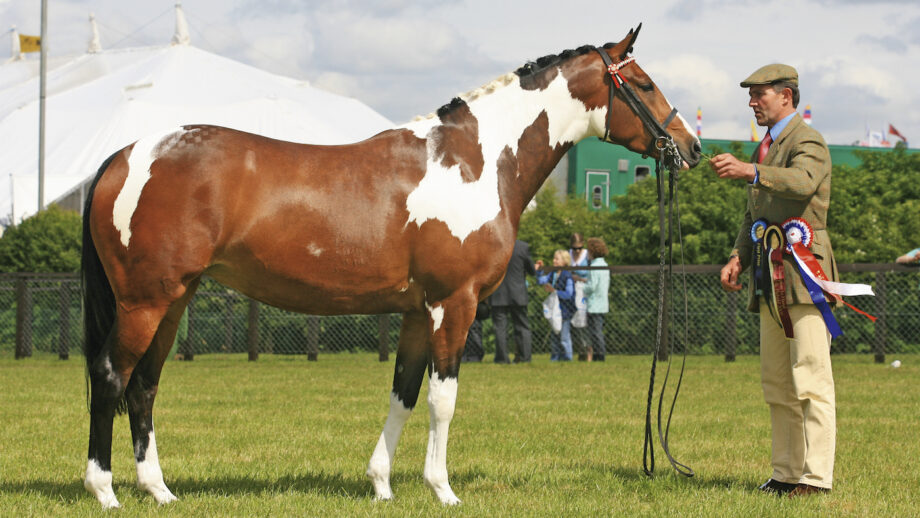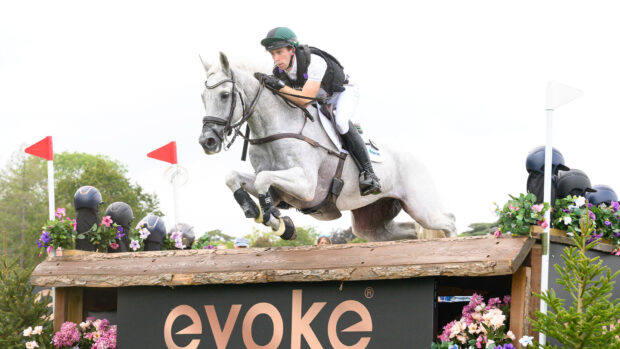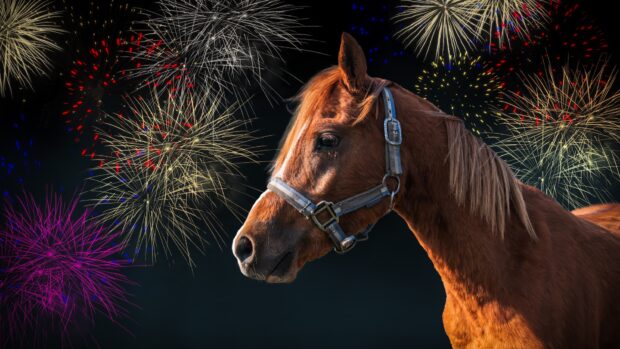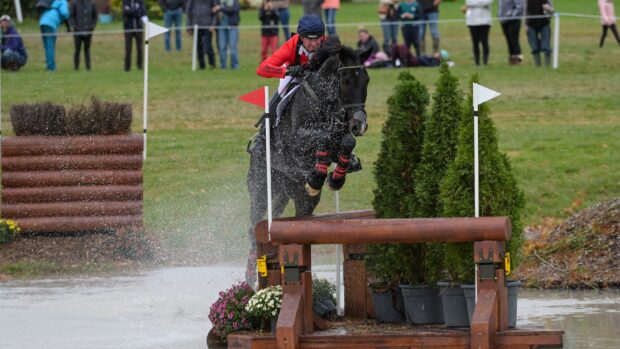Standing still in the show ring is one of the most overlooked elements, yet it’s one of the most important. Whether it’s for the initial pull, the conformation assessment, or the final line-up, your horse or pony is likely to spend more time standing than doing anything else in the ring. A pony that won’t stand quietly doesn’t just risk losing marks, it could lead to you being asked to leave the ring altogether.
To find out how to improve this often-neglected skill, we speak to top producers and judges to gather their advice on how to make standing still part of your routine and your success.
Why standing still matters in the show ring
Judge Stuart Hollings, with a wealth of experience in the showing world, is clear that preparation begins long before show day.
“There’s nothing more frustrating than a beautiful animal who’s gone foot-perfect in the go-round and individual show, only to start fussing in the line-up and upsetting the other ponies,” he says.
“Stillness must become as natural as walk, trot or canter. Too many riders finish their schooling, pop them back in the stable, and don’t practise the still bits. One trainer once told me, ‘Have a cup of tea and a piece of cake while the horse stands still’. And it stuck with me.”
Standing still quietly needs plenty of practice at home. Credit: Philip Barker
Stillness is not just about presentation; it also reflects a horse’s education and temperament. British Show Pony Society chairman and judge Paul Cook stresses how crucial it is during conformation judging.
“The conformation section makes up 50% of the mark,” he says. “A judge has a very short window to assess your animal. If it won’t stand still and square, I can’t see the limbs or body clearly. It’s a missed opportunity.”
Practising this at home is vital. Horses need to accept someone walking around them, viewing from all angles. Without this preparation, they’re likely to swing their quarters or step away just when it matters most.
Training techniques that work
{"content":"PHA+U2hvd2luZyBwcm9mZXNzaW9uYWwgU2FyYSBQYXJyb3R0LCB3aG8gd2l0aCBwYXJ0bmVyIENyYWlnIEVsZW5vciBwcm9kdWNlZCBsYXN0IHllYXLigJlzIHN1cHJlbWUgcG9ueSBvZiB0aGUgeWVhciBhdCA8YSBocmVmPSJodHRwczovL3d3dy5ob3JzZWFuZGhvdW5kLmNvLnVrLm1hc3Rlci5wdWJsaWMua2V5c3RvbmUtcHJvZC1la3MtZXV3MS5mdXR1cmVwbGMuZW5naW5lZXJpbmcubWFzdGVyLnB1YmxpYy5rZXlzdG9uZS1wcm9kLWVrcy1ldXcxLmZ1dHVyZXBsYy5lbmdpbmVlcmluZy90YWcvaG95cyIgdGFyZ2V0PSJfYmxhbmsiIHJlbD0ibm9mb2xsb3cgbm9vcGVuZXIiPkhvcnNlIG9mIHRoZSBZZWFyIFNob3c8L2E+LCBleHBsYWluczog4oCcSXTigJlzIGluY3JlZGlibHkgY29tbW9uIGZvciBjbGllbnRzIHRvIGNvbWUgZm9yIGxlc3NvbnMgYW5kIHRoZSBmaXJzdCB0aGluZyB0aGV5IHNheSBpcyB0aGUgaG9yc2Ugd29u4oCZdCBzdGFuZCBzdGlsbCBpbiB0aGUgcmluZy48L3A+Cgo8cD7igJxCdXQgSeKAmWxsIHdhdGNoIGEgY2xpZW50IGFycml2ZSBhbmQgc2VlIHRoYXQgdGhlIHBvbnkgZG9lc27igJl0IHN0YW5kIHN0aWxsIGluIHRoZSBsb3JyeSwgb3Igd2hpbGUgYmVpbmcgdGFja2VkIHVwIG9yIGJlaW5nIG1vdW50ZWQuIFlvdSBjYW7igJl0IGV4cGVjdCBhIHBvbnkgdG8gdW5kZXJzdGFuZCBhYm91dCBzdGFuZGluZyBzdGlsbCBpbiB0aGUgc2hvdyByaW5nIGlmIHlvdSBhbGxvdyBpdCB0byBmaWRnZXQgYXQgaG9tZS7igJ08L3A+CjxwPlNoZSBiZWxpZXZlcyBzdGlsbG5lc3Mgc2hvdWxkIGJlIHRhdWdodCBpbiBldmVyeSBjb250ZXh0OiBncm9vbWluZywgbGVhZGluZywgdGFja2luZyB1cCwgc3RhbmRpbmcgYXQgdGhlIGdhdGUuPC9wPgoKPHA+4oCcR28gb3V0IG9uIGEgaGFjayBhbmQgc3RvcCBmb3IgMTAgbWludXRlcyzigJ0gc2hlIHNheXMuIOKAnEluIHRoZSBzY2hvb2wsIGhhbHQgZHVyaW5nIGEgc2Vzc2lvbiBhbmQganVzdCBzdGFuZC4gVGhlIG1vcmUgbm9ybWFsIGl0IGlzLCB0aGUgY2FsbWVyIHRoZSBob3JzZSB3aWxsIGJlIHdoZW4gaXQgY291bnRzLuKAnTwvcD4KPGRpdiBpZD0iYXR0YWNobWVudF84OTE2NDAiIHN0eWxlPSJ3aWR0aDogMTQxMHB4IiBjbGFzcz0id3AtY2FwdGlvbiBhbGlnbm5vbmUiPjxpbWcgZmV0Y2hwcmlvcml0eT0iaGlnaCIgZGVjb2Rpbmc9ImFzeW5jIiBhcmlhLWRlc2NyaWJlZGJ5PSJjYXB0aW9uLWF0dGFjaG1lbnQtODkxNjQwIiBjbGFzcz0ibGF6eWxvYWQgYmx1ci11cCBzaXplLWZ1bGwgd3AtaW1hZ2UtODkxNjQwIiBkYXRhLXByb2Nlc3NlZCBzcmM9Imh0dHBzOi8va2V5YXNzZXRzLnRpbWVpbmN1ay5uZXQvaW5zcGlyZXdwL2xpdmUvd3AtY29udGVudC91cGxvYWRzL3NpdGVzLzE0LzIwMTcvMDMvbmV3LWhoLXBsYWNlaG9sZGVyLTIwMHgyMDAucG5nIiBkYXRhLXNyYz0iaHR0cHM6Ly9rZXlhc3NldHMudGltZWluY3VrLm5ldC9pbnNwaXJld3AvbGl2ZS93cC1jb250ZW50L3VwbG9hZHMvc2l0ZXMvMTQvMjAyNS8wNS9IQUgwMC5sYl9GYXJ3YXlfZmFybV9zdG9ja19pbWFnZXNfZnV0dXJlb3duc19lbW1hX2hlcnJvZC5GQVJXQVlfRkFSTV9GVVRVUkVfT1dOU19FTU1BX0hFUlJPRDIwMjUwNDAyXzQwODIuanBnIiBhbHQ9InN0b3BwaW5nIGFuZCByZWFzc3VyaW5nIGhvcnNlIG91dCBoYWNraW5nIiB3aWR0aD0iMTQwMCIgaGVpZ2h0PSI3ODkiIGRhdGEtc2l6ZXM9ImF1dG8iIGRhdGEtc3Jjc2V0PSJodHRwczovL2tleWFzc2V0cy50aW1laW5jdWsubmV0L2luc3BpcmV3cC9saXZlL3dwLWNvbnRlbnQvdXBsb2Fkcy9zaXRlcy8xNC8yMDI1LzA1L0hBSDAwLmxiX0ZhcndheV9mYXJtX3N0b2NrX2ltYWdlc19mdXR1cmVvd25zX2VtbWFfaGVycm9kLkZBUldBWV9GQVJNX0ZVVFVSRV9PV05TX0VNTUFfSEVSUk9EMjAyNTA0MDJfNDA4Mi5qcGcgMTQwMHcsIGh0dHBzOi8va2V5YXNzZXRzLnRpbWVpbmN1ay5uZXQvaW5zcGlyZXdwL2xpdmUvd3AtY29udGVudC91cGxvYWRzL3NpdGVzLzE0LzIwMjUvMDUvSEFIMDAubGJfRmFyd2F5X2Zhcm1fc3RvY2tfaW1hZ2VzX2Z1dHVyZW93bnNfZW1tYV9oZXJyb2QuRkFSV0FZX0ZBUk1fRlVUVVJFX09XTlNfRU1NQV9IRVJST0QyMDI1MDQwMl80MDgyLTMwMHgxNjkuanBnIDMwMHcsIGh0dHBzOi8va2V5YXNzZXRzLnRpbWVpbmN1ay5uZXQvaW5zcGlyZXdwL2xpdmUvd3AtY29udGVudC91cGxvYWRzL3NpdGVzLzE0LzIwMjUvMDUvSEFIMDAubGJfRmFyd2F5X2Zhcm1fc3RvY2tfaW1hZ2VzX2Z1dHVyZW93bnNfZW1tYV9oZXJyb2QuRkFSV0FZX0ZBUk1fRlVUVVJFX09XTlNfRU1NQV9IRVJST0QyMDI1MDQwMl80MDgyLTYzMHgzNTUuanBnIDYzMHcsIGh0dHBzOi8va2V5YXNzZXRzLnRpbWVpbmN1ay5uZXQvaW5zcGlyZXdwL2xpdmUvd3AtY29udGVudC91cGxvYWRzL3NpdGVzLzE0LzIwMjUvMDUvSEFIMDAubGJfRmFyd2F5X2Zhcm1fc3RvY2tfaW1hZ2VzX2Z1dHVyZW93bnNfZW1tYV9oZXJyb2QuRkFSV0FZX0ZBUk1fRlVUVVJFX09XTlNfRU1NQV9IRVJST0QyMDI1MDQwMl80MDgyLTEzNXg3Ni5qcGcgMTM1dywgaHR0cHM6Ly9rZXlhc3NldHMudGltZWluY3VrLm5ldC9pbnNwaXJld3AvbGl2ZS93cC1jb250ZW50L3VwbG9hZHMvc2l0ZXMvMTQvMjAyNS8wNS9IQUgwMC5sYl9GYXJ3YXlfZmFybV9zdG9ja19pbWFnZXNfZnV0dXJlb3duc19lbW1hX2hlcnJvZC5GQVJXQVlfRkFSTV9GVVRVUkVfT1dOU19FTU1BX0hFUlJPRDIwMjUwNDAyXzQwODItMzIweDE4MC5qcGcgMzIwdywgaHR0cHM6Ly9rZXlhc3NldHMudGltZWluY3VrLm5ldC9pbnNwaXJld3AvbGl2ZS93cC1jb250ZW50L3VwbG9hZHMvc2l0ZXMvMTQvMjAyNS8wNS9IQUgwMC5sYl9GYXJ3YXlfZmFybV9zdG9ja19pbWFnZXNfZnV0dXJlb3duc19lbW1hX2hlcnJvZC5GQVJXQVlfRkFSTV9GVVRVUkVfT1dOU19FTU1BX0hFUlJPRDIwMjUwNDAyXzQwODItNjIweDM0OS5qcGcgNjIwdywgaHR0cHM6Ly9rZXlhc3NldHMudGltZWluY3VrLm5ldC9pbnNwaXJld3AvbGl2ZS93cC1jb250ZW50L3VwbG9hZHMvc2l0ZXMvMTQvMjAyNS8wNS9IQUgwMC5sYl9GYXJ3YXlfZmFybV9zdG9ja19pbWFnZXNfZnV0dXJlb3duc19lbW1hX2hlcnJvZC5GQVJXQVlfRkFSTV9GVVRVUkVfT1dOU19FTU1BX0hFUlJPRDIwMjUwNDAyXzQwODItOTIweDUxOC5qcGcgOTIwdywgaHR0cHM6Ly9rZXlhc3NldHMudGltZWluY3VrLm5ldC9pbnNwaXJld3AvbGl2ZS93cC1jb250ZW50L3VwbG9hZHMvc2l0ZXMvMTQvMjAyNS8wNS9IQUgwMC5sYl9GYXJ3YXlfZmFybV9zdG9ja19pbWFnZXNfZnV0dXJlb3duc19lbW1hX2hlcnJvZC5GQVJXQVlfRkFSTV9GVVRVUkVfT1dOU19FTU1BX0hFUlJPRDIwMjUwNDAyXzQwODItMTIyMHg2ODguanBnIDEyMjB3IiBzaXplcz0iKG1heC13aWR0aDogMTQwMHB4KSAxMDB2dywgMTQwMHB4IiAvPjxwIGlkPSJjYXB0aW9uLWF0dGFjaG1lbnQtODkxNjQwIiBjbGFzcz0id3AtY2FwdGlvbi10ZXh0Ij5DYW4geW91IGFzayB5b3VyIGhvcnNlIHRvIHN0YW5kIHN0aWxsIGZvciAxMCBtaW51dGVzIHdoaWxlIG91dCBvbiBhIGhhY2s\/IFlvdXIgdm9pY2Ugb3IgYSBnZW50bGUgc2NyYXRjaCBtYXkgaGVscCB0aGVtIHNldHRsZS4gQ3JlZGl0OiBFbW1hIEhlcnJvZCBQaG90b2dyYXBoeTwvcD48L2Rpdj4KPHA+U3RhbmRpbmcgZm9yIHRoZSBqdWRnZSB0byBtb3VudCBpcyBhbm90aGVyIG1vbWVudCB0aGF0IGRlbWFuZHMgZm9jdXMgYW5kIGNhbG0uIFByYWN0aXNpbmcgYXQgaG9tZSB3aXRoIHNvbWVvbmUgZ2V0dGluZyBvbiBhbmQgb2ZmIGZyb20gYSBibG9jaywgYmVpbmcgbGVnZ2VkIHVwIGFuZCBhbHNvIGp1c3Qgc3RhbmRpbmcgY2xvc2UgYmVzaWRlIHRoZSBob3JzZSwgY2FuIG1ha2UgdGhlIHJlYWwgdGhpbmcgZmFyIGxlc3MgZGF1bnRpbmcuPC9wPgo8cD5Qcml6ZS1naXZpbmcgaXMgYW5vdGhlciBhcmVhIHRoYXTigJlzIG9mdGVuIGZvcmdvdHRlbiBpbiB0cmFpbmluZy48L3A+CjxwPuKAnFRoZSByb3NldHRlIGFuZCBwcml6ZS1naXZpbmcgY2FuIGNhdXNlIGVxdWFsIHByb2JsZW1zLOKAnSBTYXJhIHdhcm5zLiDigJxNYW55IGEgd2lubmVyIGhhcyBsb3N0IHRoZWlyIHJvc2V0dGUgYmVjYXVzZSB0aGV5IHdvdWxkbuKAmXQgc3RhbmQgZm9yIHRoZSBwcmVzZW50YXRpb24u4oCdPC9wPgo8ZGl2IGlkPSJhdHRhY2htZW50Xzg5MTYzNiIgc3R5bGU9IndpZHRoOiAxNDEwcHgiIGNsYXNzPSJ3cC1jYXB0aW9uIGFsaWdubm9uZSI+PGltZyBkZWNvZGluZz0iYXN5bmMiIGFyaWEtZGVzY3JpYmVkYnk9ImNhcHRpb24tYXR0YWNobWVudC04OTE2MzYiIGNsYXNzPSJsYXp5bG9hZCBibHVyLXVwIHNpemUtZnVsbCB3cC1pbWFnZS04OTE2MzYiIGRhdGEtcHJvY2Vzc2VkIHNyYz0iaHR0cHM6Ly9rZXlhc3NldHMudGltZWluY3VrLm5ldC9pbnNwaXJld3AvbGl2ZS93cC1jb250ZW50L3VwbG9hZHMvc2l0ZXMvMTQvMjAxNy8wMy9uZXctaGgtcGxhY2Vob2xkZXItMjAweDIwMC5wbmciIGRhdGEtc3JjPSJodHRwczovL2tleWFzc2V0cy50aW1laW5jdWsubmV0L2luc3BpcmV3cC9saXZlL3dwLWNvbnRlbnQvdXBsb2Fkcy9zaXRlcy8xNC8yMDI1LzA1L01PTFVDQ0FTLUJFTkdBTC1CRUFVVFktSG9yc2VObzE2ODJfUklIU19fMjE4NDgzMTQxXzMwNTcwMjk3Mi5qcGciIGFsdD0iU3RhbmRpbmcgc3RpbGwgaW4gdGhlIHNob3cgcmluZyBpbmNsdWRlcyBmb3IgdGhlIHJvc2V0dGUgYW5kIHRyb3BoeSBwcmVzZW50YXRpb24iIHdpZHRoPSIxNDAwIiBoZWlnaHQ9Ijc4OCIgZGF0YS1zaXplcz0iYXV0byIgZGF0YS1zcmNzZXQ9Imh0dHBzOi8va2V5YXNzZXRzLnRpbWVpbmN1ay5uZXQvaW5zcGlyZXdwL2xpdmUvd3AtY29udGVudC91cGxvYWRzL3NpdGVzLzE0LzIwMjUvMDUvTU9MVUNDQVMtQkVOR0FMLUJFQVVUWS1Ib3JzZU5vMTY4Ml9SSUhTX18yMTg0ODMxNDFfMzA1NzAyOTcyLmpwZyAxNDAwdywgaHR0cHM6Ly9rZXlhc3NldHMudGltZWluY3VrLm5ldC9pbnNwaXJld3AvbGl2ZS93cC1jb250ZW50L3VwbG9hZHMvc2l0ZXMvMTQvMjAyNS8wNS9NT0xVQ0NBUy1CRU5HQUwtQkVBVVRZLUhvcnNlTm8xNjgyX1JJSFNfXzIxODQ4MzE0MV8zMDU3MDI5NzItMzAweDE2OS5qcGcgMzAwdywgaHR0cHM6Ly9rZXlhc3NldHMudGltZWluY3VrLm5ldC9pbnNwaXJld3AvbGl2ZS93cC1jb250ZW50L3VwbG9hZHMvc2l0ZXMvMTQvMjAyNS8wNS9NT0xVQ0NBUy1CRU5HQUwtQkVBVVRZLUhvcnNlTm8xNjgyX1JJSFNfXzIxODQ4MzE0MV8zMDU3MDI5NzItNjMweDM1NS5qcGcgNjMwdywgaHR0cHM6Ly9rZXlhc3NldHMudGltZWluY3VrLm5ldC9pbnNwaXJld3AvbGl2ZS93cC1jb250ZW50L3VwbG9hZHMvc2l0ZXMvMTQvMjAyNS8wNS9NT0xVQ0NBUy1CRU5HQUwtQkVBVVRZLUhvcnNlTm8xNjgyX1JJSFNfXzIxODQ4MzE0MV8zMDU3MDI5NzItMTM1eDc2LmpwZyAxMzV3LCBodHRwczovL2tleWFzc2V0cy50aW1laW5jdWsubmV0L2luc3BpcmV3cC9saXZlL3dwLWNvbnRlbnQvdXBsb2Fkcy9zaXRlcy8xNC8yMDI1LzA1L01PTFVDQ0FTLUJFTkdBTC1CRUFVVFktSG9yc2VObzE2ODJfUklIU19fMjE4NDgzMTQxXzMwNTcwMjk3Mi0zMjB4MTgwLmpwZyAzMjB3LCBodHRwczovL2tleWFzc2V0cy50aW1laW5jdWsubmV0L2luc3BpcmV3cC9saXZlL3dwLWNvbnRlbnQvdXBsb2Fkcy9zaXRlcy8xNC8yMDI1LzA1L01PTFVDQ0FTLUJFTkdBTC1CRUFVVFktSG9yc2VObzE2ODJfUklIU19fMjE4NDgzMTQxXzMwNTcwMjk3Mi02MjB4MzQ5LmpwZyA2MjB3LCBodHRwczovL2tleWFzc2V0cy50aW1laW5jdWsubmV0L2luc3BpcmV3cC9saXZlL3dwLWNvbnRlbnQvdXBsb2Fkcy9zaXRlcy8xNC8yMDI1LzA1L01PTFVDQ0FTLUJFTkdBTC1CRUFVVFktSG9yc2VObzE2ODJfUklIU19fMjE4NDgzMTQxXzMwNTcwMjk3Mi05MjB4NTE4LmpwZyA5MjB3LCBodHRwczovL2tleWFzc2V0cy50aW1laW5jdWsubmV0L2luc3BpcmV3cC9saXZlL3dwLWNvbnRlbnQvdXBsb2Fkcy9zaXRlcy8xNC8yMDI1LzA1L01PTFVDQ0FTLUJFTkdBTC1CRUFVVFktSG9yc2VObzE2ODJfUklIU19fMjE4NDgzMTQxXzMwNTcwMjk3Mi0xMjIweDY4Ny5qcGcgMTIyMHciIHNpemVzPSIobWF4LXdpZHRoOiAxNDAwcHgpIDEwMHZ3LCAxNDAwcHgiIC8+PHAgaWQ9ImNhcHRpb24tYXR0YWNobWVudC04OTE2MzYiIGNsYXNzPSJ3cC1jYXB0aW9uLXRleHQiPlRoZSBhYmlsaXR5IHRvIHN0YW5kIHN0aWxsIGluIHRoZSBzaG93IHJpbmcgaW5jbHVkZXMgZm9yIHRoZSByb3NldHRlIGFuZCB0cm9waHkgcHJlc2VudGF0aW9uIOKAkyBpbiBhIGJ1c3kgYW5kIHNwb29reSBhcmVuYSwgd2hhdGV2ZXIgdGhlIHdlYXRoZXIuIENyZWRpdDogUGV0ZXIgTml4b248L3A+PC9kaXY+CjxwPlNhcmEgcmVjcmVhdGVzIHByaXplLWdpdmluZyBzZXR0aW5ncyB0byBoZWxwIGhvcnNlcyBwcmVwYXJlLjwvcD4KPHA+4oCcV2UgdXNlIGZsb3dlcnMsIGdhdGVzLCBiYW5uZXJzLCBhbnl0aGluZyB0aGV5IG1pZ2h0IHNlZSBpbiBhIGNoYW1waW9uc2hpcCBhcmVuYSzigJ0gc2hlIHNheXMuIOKAnFdlIHByYWN0aXNlIHN0YW5kaW5nIG5leHQgdG8gdGhlc2UgdGhpbmdzLCBiZWluZyBoYW5kZWQgcm9zZXR0ZXMgb3IgaGF2aW5nIGEgc2FzaCBwbGFjZWQgb3ZlciB0aGUgYm9keS48L3A+CjxwPuKAnEV2ZW4gYSBwaG90b2dyYXBoZXIgcmF0dGxpbmcgc29tZXRoaW5nIHRvIGdldCBlYXJzIGZvcndhcmQgY2FuIHNwb29rIGEgaG9yc2UgaWYgaXTigJlzIG5vdCBiZWVuIGV4cG9zZWQgdG8gaXQgYmVmb3JlLuKAnTwvcD4KPGgyPlRyb3VibGVzaG9vdGluZyBjb21tb24gaXNzdWVzPC9oMj4KPHA+R2F5bGUgSG9sZGVyLCBzdWNjZXNzZnVsIHNob3cgcHJvZHVjZXIgd2l0aCBoZXIgZGF1Z2h0ZXIgRW1tYSwgd29ya3Mgd2l0aCBhIHdpZGUgcmFuZ2Ugb2YgY2xpZW50cyBhbmQgYmVsaWV2ZXMgcGF0aWVuY2UgYW5kIHJlcGV0aXRpb24gYXJlIGtleS48L3A+CjxwPuKAnEhvcnNlcyBmZWVkIG9mZiByaWRlciBlbmVyZ3ks4oCdIHNoZSBzYXlzLiDigJxZb3Ugd2FudCB0aGUgcG9ueSB0byByZWxheCwgYnV0IHRoYXQgZG9lc27igJl0IG1lYW4gdGhlIHJpZGVyIHNob3VsZCBzbHVtcCBpbiB0aGUgcmluZy4gSnVkZ2VzIGNhbiBsb29rIGRvd24gdGhlIGxpbmUgYXQgYW55IG1vbWVudC4gVGhlIHJpZGVyIGhhcyB0byBzdGF5IHNoYXJwIHRvby7igJ08L3A+CjxwPkZvciBhbnhpb3VzIG9yIGZpZGdldHkgaG9yc2VzLCBzaGUgcmVjb21tZW5kcyBsaWdodCBwaHlzaWNhbCBjdWVzIHN1Y2ggYXMgc2NyYXRjaGluZyB0aGUgd2l0aGVyIG9yIHNvZnQgdm9pY2UgcmVhc3N1cmFuY2UgdG8gaGVscCB0aGVtIHNldHRsZS4gQnV0IHNoZSBhbHNvIHdhcm5zIG5vdCB0byByZWluZm9yY2UgYSBiZWhhdmlvdXIgeW91IGRvbuKAmXQgd2FudC48L3A+CjxwPuKAnElmIGEgaG9yc2UgZmlkZ2V0cyBhbmQgeW91IG1vdmUgdGhlbSBvbiBvciByZXdhcmQgdGhlbSwgdGhhdCBpcyBlbmNvdXJhZ2luZyB0aGVtIHRvIHJlcGVhdCB0aGF0IGJlaGF2aW91cizigJ0gc2hlIHNheXMuIOKAnFdhaXQgdW50aWwgdGhleeKAmXJlIGNhbG0gYmVmb3JlIGdpdmluZyBwcmFpc2UuIENvbnNpc3RlbmN5IGlzIGV2ZXJ5dGhpbmcu4oCdPC9wPgo8cD5EaXN0cmFjdGlvbnMgaW4gdGhlIHJpbmcgc3VjaCBhcyBvdGhlciBwb25pZXMsIGxvdWRzcGVha2VycyBhbmQgc3BlY3RhdG9ycyBhbGwgYWRkIHRvIHRoZSBwcmVzc3VyZS4gVGhlIG1vcmUgeW91IGV4cG9zZSB5b3VyIGhvcnNlIHRvIHNpbWlsYXIgc2l0dWF0aW9ucyBhdCBob21lLCB0aGUgbW9yZSBjb25maWRlbnQgYW5kIHN0aWxsIHRoZXnigJlsbCBiZSBvbiB0aGUgZGF5LjwvcD4KPGgyPk1ha2UgaXQgcGFydCBvZiB0aGUgcm91dGluZTwvaDI+CjxkaXYgY2xhc3M9ImluamVjdGlvbiI+PC9kaXY+CjxwPlN0YW5kaW5nIHN0aWxsIGlzbuKAmXQganVzdCBhIHNraWxsIGZvciBzaG93IGRheTsgaXTigJlzIGEgc2tpbGwgdGhhdCBzaG91bGQgYmUgYnJvdWdodCBpbnRvIHlvdXIgaG9yc2XigJlzIGRhaWx5IGxpZmUuPC9wPgo8cD7igJxTdGFuZGluZyBpcyBvZnRlbiBvdmVybG9va2VkLOKAnSBzYXlzIFN0dWFydCBIb2xsaW5ncy4g4oCcQnV0IGl04oCZcyBhIG1hcmsgb2YgYSB0cnVseSB0cmFpbmVkIGhvcnNlLuKAnTwvcD4KPHA+SXTigJlzIGFuIGltcG9ydGFudCBlbGVtZW50IG9mIGEgd2VsbC1yb3VuZGVkIHNob3cgYW5pbWFsLCBhbmQgdGhlIGNvbnNlbnN1cyBpcyBjbGVhcjogc3RhcnQgeW91bmcsIGJlIGNvbnNpc3RlbnQsIHJld2FyZCBjYWxtbmVzcywgYW5kIG1vc3Qgb2YgYWxsLCBwcmFjdGlzZS48L3A+CjxwPgo="}
Did you enjoy this article? You may also like to read…
Hunter supremo Robert Walker rides the exceptional lightweight View Point under the HOYS spotlight.
Credit: Peter Nixon
Tremarl Timber, trained to perfection to win the in-hand supreme championships at HOYS in 2023.
Credit: Peter Nixon
Who will follow in the footsteps of former Royal Windsor champion M&M, Castle Kestrel, ridden by Lucy Glover, at this year’s show?
Credit: Peter Nixon
A young horse primed to impress the judges in the ring.
Credit: H&H Archives
Credit: Elli Birch
Stay in touch with all the news in the run-up to and throughout the major shows and events during 2025 with a Horse & Hound subscription. Subscribe today for all you need to know ahead of these major events, plus online reports on the action as it happens from our expert team of reporters and in-depth analysis in our special commemorative magazines. Have a subscription already? Set up your unlimited website access now












